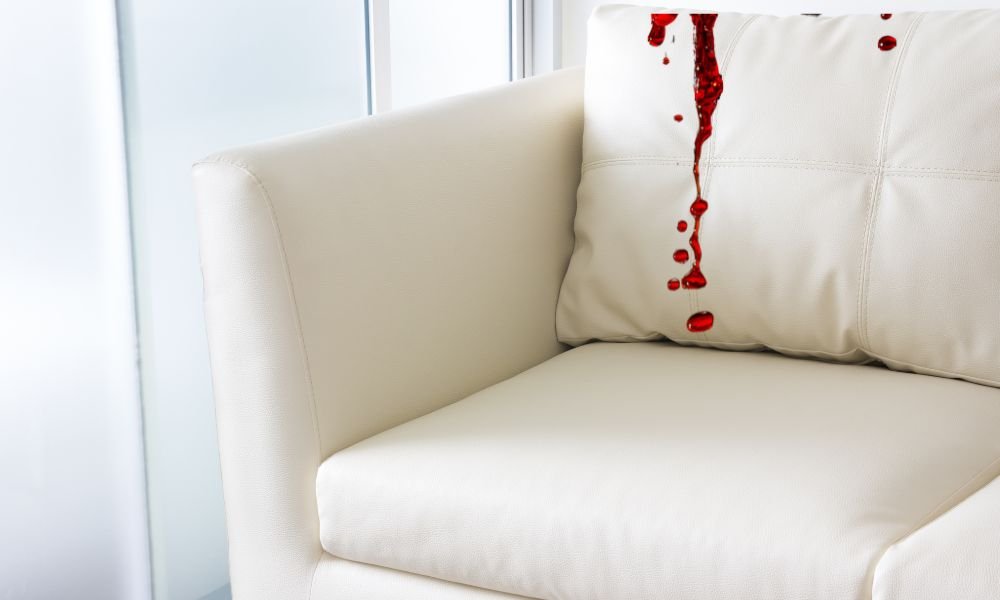Accidents happen, and one of the trickiest stains to remove is blood—especially from a sofa. Upholstered furniture requires delicate handling to ensure the stain is removed without damaging the fabric. Here, we’ll provide an in-depth, step-by-step guide on how to get rid of blood stains on your sofa. From assessing fabric type to using effective solutions, this guide covers everything you need to know.
Understanding the Fabric of Your Sofa
The first step in removing blood stains effectively is understanding the material of your sofa. Different fabrics, such as cotton, linen, leather, or microfiber, respond uniquely to cleaning agents. Leather, for instance, is very sensitive to moisture, while microfiber can handle some wet cleaning techniques. Before applying any cleaning method, check the care label on your sofa. This helps avoid any damage while you work on how to get rid of blood stains on the sofa.
Immediate Steps to Take When Blood Spills
Time is of the essence when it comes to blood color. Fresh blood is easier to remove, so act quickly to prevent it from setting into the fibers. Grab a clean cloth or paper towel and gently blot the area—do not rub. Rubbing spreads the stain and pushes it deeper into the fabric. Blotting will absorb most of the gore before it penetrates too deeply.
Using Cold Water to Remove Fresh Blood Stains
One of the most effective methods for fresh blood color is cold water. Hot water causes gore to coagulate, making it harder to remove. Soak a clean cloth in cold water and gently dab it on the stained area. This works especially well on lighter stains or stains that haven’t dried.
Blotting Technique to Avoid Spreading the Stain
Blotting is critical when handling blood stains. After applying cold water, blot the stain from the outer edges toward the center. This technique helps prevent the stain from spreading outward, a common mistake in stain removal. Keep a fresh cloth handy to replace as it becomes saturated with blood, ensuring you’re not redepositing the stain onto the fabric.
Hydrogen Peroxide for Stubborn Stains
For dried or stubborn blood color, hydrogen peroxide is a common solution. However, it can bleach certain fabrics, so always do a spot test in an inconspicuous area. If safe, pour a small amount of hydrogen peroxide onto the stain, and let it sit for a few minutes. Dab the area with a clean cloth to lift the stain. This method is particularly effective for removing set-in color when learning how to get rid of blood stains on a sofa.
Salt Paste for Natural Stain Removal
Salt, when mixed with cold water to create a paste, can be an effective natural stain remover. Spread the paste onto the blood stain and let it sit for around 10–15 minutes. Once it has set, use a damp cloth to wipe away the salt. This method is mild and suitable for most fabrics, although it may require a few repetitions for tougher marks.
Baking Soda Solution for Blood Stains on Sofa
Baking soda has natural lifting properties and is gentle on fabrics. Mix one part baking soda with two parts water to create a paste, then apply it directly to the stain. Let it sit for 30 minutes, then wipe it off with a clean, damp cloth. Baking soda is an excellent option if you’re looking for a simple and natural way to address how to get rid of blood stains on a sofa.
Dish Soap and Cold Water for Light Stains
For smaller or less intense colors, mild dish soap mixed with cold water can often do the trick. Combine a few drops of dish soap with a cup of water, then dip a cloth into the solution and gently dab it onto the stain. Rinse the area with another cloth soaked in plain cold water to remove any soap residue.
Enzyme-Based Cleaners for Protein Stains
Blood stains are protein-based, so enzyme cleaners, which break down proteins, can be very effective. Check the label to ensure the cleaner is safe for use on your sofa’s fabric. Apply as directed, and always blot the stain to prevent spreading. Enzyme cleaners can penetrate deep, breaking down the stain from within.
Vinegar and Cornstarch Method for Deep Color
Mixing vinegar and cornstarch can create a thick paste that’s excellent for deep blood taint. Apply the paste, let it dry, and then brush it off. Vinegar helps lift the stain, while cornstarch draws it out of the fabric fibers. This solution is safe for many upholstery types but should be tested in an inconspicuous area first.
When to Call Professional Cleaners
If the blood stain is particularly stubborn or if you’re concerned about damaging your sofa, it may be time to call in professionals. They have specialized cleaning solutions and equipment designed for delicate fabrics. Knowing when a stain is beyond home remedy techniques can save your sofa from potential damage.
Preventing Future Stains on Your Sofa
Prevention is key to maintaining a spotless sofa. Consider applying a fabric protector spray to your sofa. It helps repel liquids, making it easier to clean up spills before they have a chance to stain. Using slipcovers can also offer an extra layer of protection, especially if you have children or pets. Routine cleaning additionally helps, ensuring that dirt doesn’t collect and flip minor stains into cussed spots.
Removing blood stains from a settee can be daunting, but with the right techniques, you can protect your upholstery and keep it searching clean. Whether you’re using hydrogen peroxide for tough stains or opting for a salt paste as a natural alternative, the methods listed here offer a range of solutions. Remember, brief motion is the best way to prevent a minor spill from turning into an enduring stain. By following this guide on how to get rid of blood stains on a sofa, you can confidently handle even the most challenging mark.
